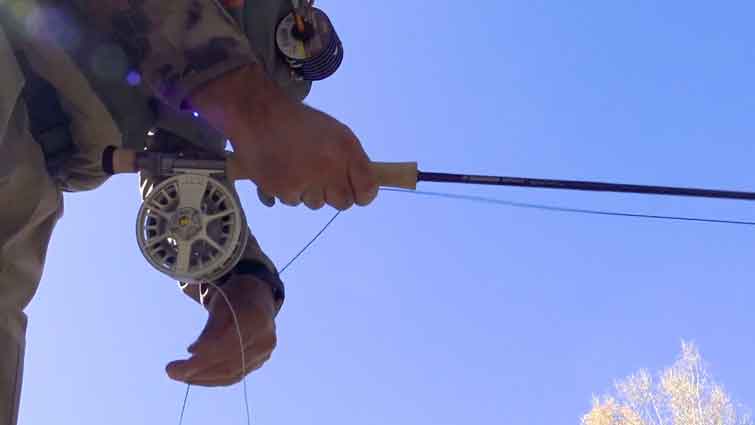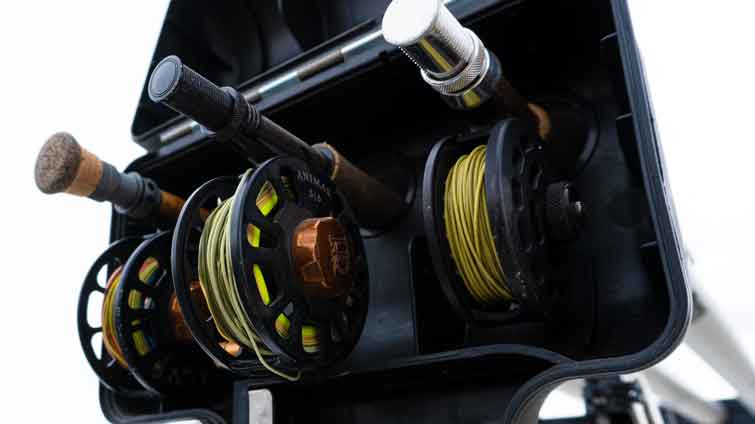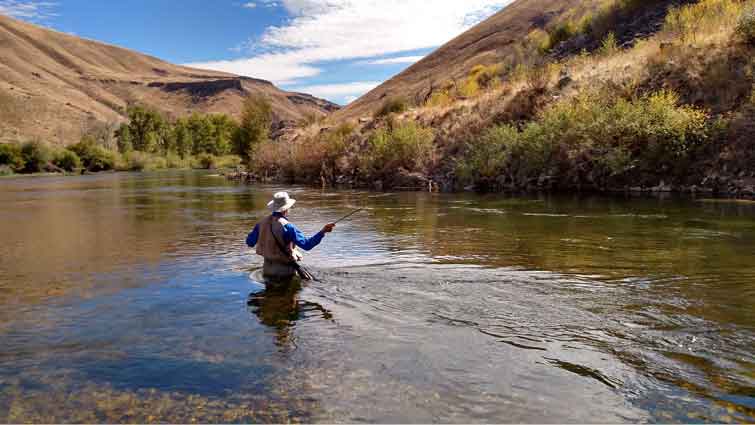How Do You Pick a Fly Reel for Trout? There are a few things to consider when picking a fly reel for trout to add to your fly fishing gear. The size of the trout, the weight of the fly line you will be using, and the type of water you will be fishing are all crucial factors.
The most significant factor to consider when purchasing a fly reel is the capacity of the reel to hold enough backing and fly line for the weight of the rod you will be using. A lightweight reel is ideal for picking a fly reel for smaller trout. For larger trout or in deeper water, you will need a heavier reel that can handle a heavier fly line.

There are many different fly reels on the market today, and it can be challenging to decide which one is right for you. This article will look at some factors to consider when choosing a fly reel for trout. Additionally, we'll look at fly fishing reel size guides to help you make the best choice for your circumstances!
What Should I Look for When Picking a Fly Reel for Trout?
There are hundreds of reels on the market, but not all are appropriate for trout fishing. When selecting a reel, you'll need to consider factors such as the weight of the rod, the size of the fish you're targeting, and the amount of line you'll need to hold.
Some of the most significant factors to look at when choosing a fly reel for trout include:
- Price
- Material
- Drag System
- Arbor Size
The most crucial factor to consider is the size of the fly reel. You'll want a reel that can accommodate enough backing and fly line for your chosen rod. If you're using a light-action rod, you'll need a smaller reel than if you're using a heavier rod. Heavier rods require larger reels to handle the increased casting weight.

1. Price
The price of a fly reel is often indicative of the quality of the reel. However, you don't need to spend a fortune on a fly reel to get a good one. There are many quality reels available for around $100. High-end fly reels can cost upwards of $900, but those are generally reserved for the most avid anglers.

2. Material
There are many features to consider when choosing a fly reel, like material. Most modern fly reels are made from anodized aluminum, which is solid and lightweight. Reels can also be made from carbon fiber, magnesium, or stainless steel. Each has its benefits and drawbacks.
The material used to make a fly reel also affects its price and quality. Reels made of aluminum are typically less expensive than titanium or carbon fiber. However, aluminum can corrode over time if not correctly cared for. Titanium and carbon fiber are more durable but also more expensive.

3. Drag System
A drag system is essential because it allows you to apply pressure to the fish as it takes the line from the reel. This prevents the line from breaking and helps you land the fish. A sound drag system will have a wide range of adjustments, so you can apply as much or as little pressure as you need.
A good drag system will allow you to adjust the resistance on the spool, which is essential when fighting a fish. There are a variety of drag systems available, but most moderate-to-expensive reels employ a form of disc drag. A disc drag comprises several discs from self-lubricating materials that generate different levels of friction as the drag knob is tightened.
In trout fishing, this isn't as significant because typically, the fish isn't going to pull line very much off the reel unless it is a larger trout that takes you on the run. However, in trout fishing, even if the fish doesn't pull a lot of line off the reel, having a proper drag setting is still essential in preserving your tippet.

The Difference Between Disc Drag and Click-and-Pawl
Disc drag systems use a brake system to slow the spool down when fighting a fish. This system provides more consistent drag pressure throughout the fight, which is helpful when trying to land a big fish.
Click-drag systems use cogs and gears to provide resistance against the spool. This type of drag is not as smooth as disc drag systems, but it is simpler and less expensive. It is a good choice for smaller fish or when you need to reel in your line quickly.
4. Arbor Size
The arbor size also affects the price and quality of a fly reel. A larger spool can hold more line, which is vital if you plan to fish for large trout. However, a larger spool also means that the reel is heavier and takes up more space in your pack.
All reels have a simple, conventional spindle in the middle where the line could be attached and wound. It typically takes a lot of turns to wind the line and backing on a reel. However, with the additions of medium and large arbors, lines can be wound much quicker. Because large arbor reels are significantly more prominent in diameter, they can wind line three times as fast or faster, which is a significant advantage for saltwater fly fishing.

For trout fishing, the smaller traditional reel is the ideal choice due to its lightweight and aesthetic balance with a light trout rod. However, mid-sized arbors are becoming increasingly popular among trout anglers.
The overall size of the reel also affects its price and quality. A larger reel is heavier and takes up more space, but it also has more features and lasts longer than a smaller reel. The size of the reel you choose is ultimately up to your personal preference, but make sure you consider what type of fishing you will be doing with it.

Fly Fishing Reels: Size Guide
When choosing a fly reel for trout, you should also consider the type of water you will be fishing. If you are fishing in fast-moving water or streams, you will need a reel with more drag to prevent the line from being pulled from the reel. If you will be fishing in calm water, a less aggressive drag is appropriate.
Most fly reels are measured in weight and range from 3 to 12. As a rule of thumb, your fly reel weight should match that of your rod. For example, if you bought a 5-weight fly rod, make sure the fly reel you choose can handle line weights ranging from 4 to 6.
Here is a quick guide for fly reel sizing and the type of fish/fishing that correlates with each size:
|
Reel Size (Weight) |
Type of Fish |
|
3-4 |
Small trout |
|
5 |
Average trout/ Typical fly fishing |
|
6-7 |
Bass/ Streamer fishing |
|
8-9 |
Bass, Pike, Large Sea Trout, Steelhead |
|
10-12 |
Tarpon/ Large saltwater fish |
Fly fishing reels come in various sizes, and the size you choose will depend on the weight of the line you are using. Heavier lines require a larger reel to prevent spinning out, while a smaller reel can handle lighter lines. It is essential to select a reel that is not too small or too large for the line weight you are using, as this can affect the overall performance of your setup.
Frequently Asked Questions About Reels
Here are some of the most frequently asked questions about fly reels, their weight, and how to pick the ideal size for your type of fishing.

How Do I Know What Size Fly Reel to Get?
Because fly reels come in multiple sizes, knowing which one to choose can be confusing. It is important to select a reel that is not too small or too large for the line weight you are using, as this can affect the overall performance of your setup.
To know what size fly reel to get, consider the type of fishing you'll be doing. If you will mostly be fishing for trout, a reel rated for a 3-5 weight is a good choice. For larger fish such as bass or pike, you'll need a reel that can handle heavier line weights, such as 6 or 8 weight.

How Do You Pick a Fly Reel?
Choosing a fly reel is a personal decision, and there is no one perfect answer. Some factors to consider include the weight and size of the reel, the drag system, and the price.
When picking a fly reel, you'll want to consider the weight first. Heavier reels are generally sturdier and can handle bigger fish. Lighter reels are less bulky and easier to carry around, but they may not be as durable. You'll need to consider the type of fishing you plan on doing and the weight of your rod as well.

Does Fly Reel Weight Matter?
When selecting a fly line, it's critical to match the line weight with the rod weight to guarantee optimum casting and performance when fly fishing.
The size of the fly reel definitely matters. You'll want to choose a reel that is appropriate for the size of your rod and the type of fish you're after. Most trout rods are between 6 and 8 weight, so you'll want to choose a reel that matches that weight range.

How Much Does a Good Fly Reel Cost?
Fly reels range significantly in price, starting as low as $25 and increasing to $1,000 or more. So, how do you know which reel is right for you?
The price of a fly reel usually reflects its quality. A more expensive reel typically has better machining and materials, making it more durable. It also tends to have a smoother drag system, which is important when fighting big fish.
You don't necessarily need to spend a lot of money to get a good reel. There are many great options available for under $200. Just be sure to do your research and find one that fits your needs.
What Is a Good Fly Reel for Beginners?
There are various fly reels that are ideal for beginners. In general, a good fly reel for beginners should have a moderate drag system, be easy to use and maintain, and be affordable.
The Echo Ion Fly Wheel is one of the best options for beginners. It comes in 2-12 wt, with a large arbor, maintenance-free disc drag, and is made from a durable machine/cast designed material.

Can Fly Reels Get Wet?
When it comes to your fly reel setup, you don't have to worry about rain and water. However, you should avoid getting your fly reel submerged in water.
If you are planning on fishing in wet conditions, light rain won't be an issue. Fly reels can get wet, but avoid submerging them in water. If you drop your reel in the water, rinse it with fresh water thoroughly, and you should be set!
It would be best to clean your fly reel after every outing, whether it's been wet or not. This will help keep it functioning properly and looking good.
Picking a fly reel for trout fishing can be a daunting task. There are many factors to consider, such as weight, drag system, and price. It's important to find a reel that is the right fit for you and your budget. Remember to clean your reel after every outing, regardless of whether it was wet or not. With a little bit of research and some practice, you'll be able to select the perfect fly reel for your needs!





